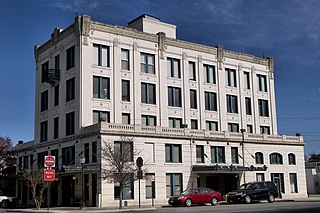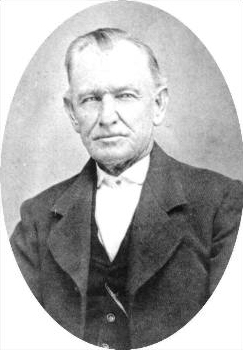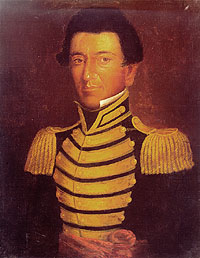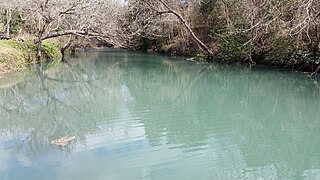
McCulloch County is a county located on the Edwards Plateau in the U.S. state of Texas. At the 2020 census, its population was 7,630. Its county seat is Brady. The county was created in 1856 and later organized in 1876. It is named for Benjamin McCulloch, a famous Texas Ranger and Confederate general.

Hudspeth County is a county located in the U.S. state of Texas. As of the 2020 census, the population was 3,202. Its county seat is Sierra Blanca, and the largest community is Fort Hancock. The county is named for Claude Benton Hudspeth, a state senator and United States Representative from El Paso. It is northeast of the Mexico–U.S. border.

Hays County is a county in the central portion of the U.S. state of Texas. It is part of the Austin-Round Rock metropolitan area. As of the 2020 census, its official population had reached 241,067. The county seat is San Marcos. Hays, along with Comal and Kendall Counties, was listed in 2017 as one of the nation's fastest-growing counties with a population of at least 10,000. From 2015 to 2016, Hays County, third on the national list, had nearly 10,000 new residents during the year.

Guadalupe County is a county located in the U.S. state of Texas. As of the 2020 census, its population was 172,706. The county seat is Seguin. The county was founded in 1846 and is named after Guadalupe River.

Seguin is a city in and the county seat of Guadalupe County, Texas, United States; as of the 2020 census, its population was 29,433. Its economy is primarily supported by a regional hospital, as well as the Schertz-Seguin Local Government Corporation water-utility, that supplies the surrounding Greater San Antonio areas from nearby aquifers as far as Gonzales County. Several dams in the surrounding area are governed by the main offices of the Guadalupe-Blanco River Authority, headquartered in downtown Seguin.

Henry Eustace McCulloch was a soldier in the Texas Revolution, a Texas Ranger, and a brigadier general in the army of the Confederate States during the American Civil War.

Juan Nepomuceno Seguín was a Spanish-Tejano political and military figure of the Texas Revolution who helped to establish the independence of Texas. Numerous places and institutions are named in his honor, including the county seat of Seguin in Guadalupe County, the Juan N. Seguin Memorial Interchange in Houston, Juan Seguin Monument in Seguin, World War II Liberty Ship SS Juan N. Seguin, Seguin High School in Arlington.

Fort Phantom Hill, also called the Camp on the Clear Fork, is a former United States Army installation located in Jones County, Texas. The fort was established in 1851 as part of a line of forts in Texas to protect migrants passing through the state on their way to California. The US Army abandoned the fort in 1854 and it was shortly thereafter mostly destroyed by fire. In 1858, it became a station of the Butterfield-Overland Mail route until it moved out of Texas with the beginning of the American Civil War in 1861. During the war, the fort was occupied by Confederate frontier troops until the Confederacy's defeat and surrender. Following the US Army's return to Texas after the Civil War, Fort Phantom Hill was used as a subpost of the larger, newer Fort Griffin until 1875.

Lynchburg is an unincorporated community in east central Harris County, Texas, United States.

Matthew Caldwell,, also spelled Mathew Caldwell was a 19th-century Texas settler, military figure, Captain of the Gonzales – Seguin Rangers and a signer of the Texas Declaration of Independence. Because of his recruitment ride ahead of the Battle of Gonzales, some call him the Paul Revere of Texas.
James Milford Day was a 19th-century Texas military figure. He was a member of Mathew Caldwell's and Jack Hay's Seguin Rangers and a participant in the Mexican–American War.

Ferdinand C. Weinert was a merchant and politician from Seguin, Texas, who served in the Texas Legislature, four years in the Senate and four terms in the House, and well as serving as Secretary of State.
Arthur Swift was a 19th-century Texas merchant, surveyor, political and military figure. He, along with Rangers Mathew Caldwell, and James Campbell, were founders of Seguin, Texas. He participated in the Texas–Indian wars. He served as a member of the Texas House of Representatives from the Gonzales district in the First Texas Legislature. After Guadalupe County was established with his hometown of Seguin as the county seat, Swift used his influence with the county commissioners to move the route of a planned road from Seguin to San Antonio.
Andrew Jackson Sowell was a lifelong soldier and farmer in the 19th century. He was a participant in the Texas Revolution and a survivor of the siege of the Alamo. He continued his service during the years of the Republic of Texas, in the Mexican–American War, and the Civil War. He was a frontier defender, early Texas Ranger, and a friend and scout with Kit Carson.

Saffold Dam at the Flores Crossing is a dam and man-made waterfall in the city of Seguin, Texas. Named for William Saffold, a Civil War veteran, a major landowner and local merchant. The dam was listed on the National Register of Historic Places on November 15, 1979.

The Robert Hall House is a historic 1830s home on the Walnut Branch. The house was the residence of the early ranger, Robert Hall (1814–1899). It is among the oldest structures still standing in Seguin, Texas.

Los Nogales is a historic 1800s home, among the oldest structures still standing in Seguin, Texas and is the last remaining adobe constructed home in the city. It serves the community as a museum.

Geronimo Creek is a stream in South Central Texas, U.S., that runs approximately 17 miles, from its source one mile east of Clear Springs, Texas, to its confluence with the Guadalupe River in Guadalupe County, Texas, three miles southeast of Seguin.
Schumansville is a historic German settlement in Guadalupe County, Texas, United States. It is an unincorporated community.





















